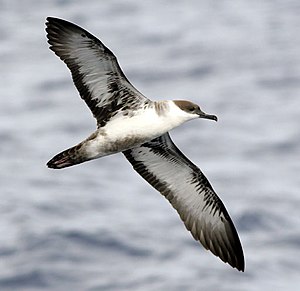Great shearwater
| Great shearwater | ||||||||||
|---|---|---|---|---|---|---|---|---|---|---|

Great Shearwater ( Puffinus gravis ) |
||||||||||
| Systematics | ||||||||||
|
||||||||||
| Scientific name | ||||||||||
| Puffinus gravis | ||||||||||
| ( O'Reilly , 1818) |
The great shearwater ( Puffinus gravis ), sometimes referred to as the cap shearwater , is a large seabird belonging to the tube-nosed order .
The great shearwater is a regular, albeit rare, guest bird on the European coasts of the south and west Atlantic. In Central Europe, on the other hand, this species is an extremely rare exceptional guest. Confirmed observations are available for Heligoland for October 1986, among others, and it was observed on Sylt in October 1983.
description
The great shearwater is 43 to 51 cm long and has a wingspan of 105 to 122 cm. The upper side is mostly monochrome dark brown with a white neck band and sharply set off white upper tail-coverts. The underside is predominantly white, with the exception of dark markings on the arm wing and under tail, a diffuse dark belly spot and dark wings and tail feathers. The black-brown cap, which is sharply set off against the white underside, and the relatively slim, black beak are characteristic. The flight of the great shearwater shows the typical lateral movements of the shearwater, in which they swing back and forth with stiff wings and a few wing beats close to the water. The Atlantic Shearwater has a similar flight but is smaller. The only shearwater similar in size is the dark shearwater , but whose trunk is completely dark brown.
Distribution and migration behavior
The great shearwater breeds on Nightingale Island and Inaccessible , which are part of the Tristan da Cunha archipelago , and on Gough Island . All of these volcanically formed islands are far away from larger land masses in the southern Atlantic . It is one of the few migratory birds that migrate from their breeding areas in the southern hemisphere to the northern hemisphere, while the more widespread direction is the opposite. The great shearwater follows a circular route. It initially moves on the east coast of South and North America before crossing the Atlantic in August. In autumn he stays in the western North Atlantic from the coast of Iceland to Portugal. It is only found sporadically in the North Sea and the western Mediterranean as far as Sardinia.
food
The great shearwater lives on fish and squids, which it catches from the surface of the water or by shock diving. He likes to follow fishing boats where noisy bickering can take place. Great shearwaters have a pervasive reputation that they usually utter while resting in groups on the water.
Reproduction
The shearwater nests in large colonies and only lays a single egg in a hollow in the open grasslands. The nests are only visited at night to avoid being captured by large seagulls .
Systematics
The systematic position of the species is unclear. It belongs to a group of large species that could be separated as the genus Ardenna (Penhallurick & Wink 2004); In this genus it could be summarized with similar species such as the short-tailed shearwater and especially the dark shearwater , which also have dark plumage and blunt-ended tails. Alternatively, it has been suggested (Austin 1996, Austin et al. 2004) that the great shearwater could be a monotypical subspecies “Ardenna sensu stricto”, a member of the thin-beaked “Hemipuffinus” group ( blue- footed shearwater and pink-footed shearwater ) living in the Atlantic area. .
swell
The article is essentially based on a translation from en.Wikipedia, version of June 13, 2007.
literature
- Austin, Jeremy J. (1996): Molecular Phylogenetics of Puffinus Shearwaters: Preliminary Evidence from Mitochondrial Cytochrome b Gene Sequences. Molecular Phylogenetics and Evolution 6, Volume 1: pp. 77-88. doi : 10.1006 / mpev.1996.0060
- Austin, Jeremy J .; Bretagnolle, Vincent & Pasquet, Eric (2004): A global molecular phylogeny of the small Puffinus shearwaters and implications for systematics of the Little-Audubon's Shearwater complex. Auk 121 issue 3: pp. 847–864. doi : 10.1642 / 0004-8038 (2004) 121 [0847: AGMPOT] 2.0.CO; 2
- Harrison, Peter (1987): Seabirds of the world: a photographic guide . Princeton University Press, Princeton. ISBN 0-691-01551-1
- Heidrich, Petra, Amengual, José F. & Wink, Michael (1998): Phylogenetic relationships in Mediterranean and North Atlantic shearwaters (Aves: Procellariidae) based on nucleotide sequences of mtDNA. Biochemical Systematics and Ecology 26 Volume 2: pp. 145-170. doi : 10.1016 / S0305-1978 (97) 00085-9 PDF
- Penhallurick, John & Wink, Michael (2004): Analysis of the taxonomy and nomenclature of the Procellariformes based on complete nucleotide sequences of the mitochondrial cytochrome b gene. Emu 104, No. 2: pp. 125-147. doi : 10.1071 / MU01060
- Svensson, Lars, Peter J. Grant, Killian Mullarney, Dan Zetterström: The new cosmos bird guide . Kosmos, Stuttgart; 1999. ISBN 3-440-07720-9
Web links
- Videos, photos and sound recordings of Puffinus gravis in the Internet Bird Collection
- Ardenna gravis inthe IUCN 2012 Red List of Threatened Species . 2. Listed by: BirdLife International, 2012. Retrieved November 17, 2012.
Individual evidence
- ↑ Hans-Günther Bauer, Einhard Bezzel and Wolfgang Fiedler (eds.): The compendium of birds in Central Europe: Everything about biology, endangerment and protection. Volume 1: Nonpasseriformes - non-sparrow birds , Aula-Verlag Wiebelsheim, Wiesbaden 2005, ISBN 3-89104-647-2 , p. 215